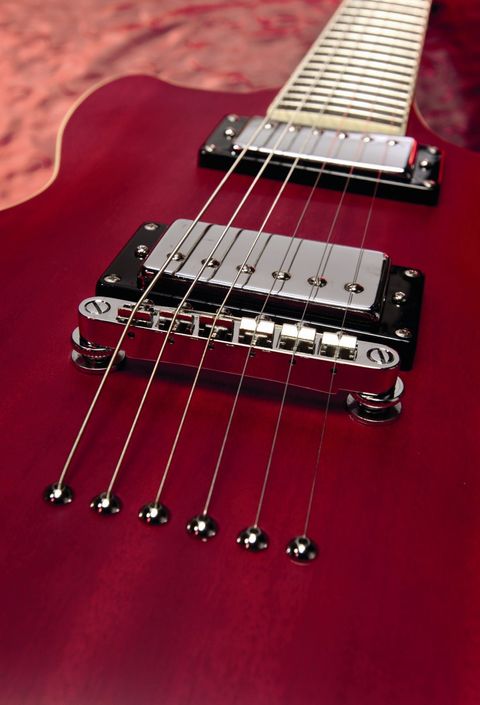We first encountered Adam Black guitars in 2006 in the shape of some great value hollow-bodied jazzers. In 2007, the company debuted some solid-body electric designs, including the Apollo and this Orion.
The cherry hue of the Orion possesses a little more visual elegance than the stripped wood finish of the Apollo. The transparent satin finish complements its lightly arched mahogany body nicely, this time with a glued neck joint which should provide a subtle sonic alternative.
The body itself tapers to a thin 31mm depth at its edge, unlike the slab-like Apollo which is a shade under 40mm.
The Orion is certainly going to appeal to players who like their guitars to be a little more curvaceous, and there's something of the character of the Gretsch Malcolm Young G6131MY signature model about it that is rather appealing.
In contrast to the largely Spartan aesthetic evoked by both instruments, once again we'd have to find fault with the abalone-inlaid 'Black' headstock logos on taste grounds - for us they look rather tacky in this context.
Surely a plain white or cream logo in a smaller typeface would sit much more comfortably with the overall vibe? Minor visual quibbles aside, the aforementioned set and thru-necks should ensure that there's no shortage of sustain, especially in combination with through-body stringing.
Both the Apollo and this Orion share a number of other common features, including the reassuringly solid presence of Grover tuners, a tune-o-matic-style tailpiece and dual high output ceramic magnet humbuckers, while wiring is a simple no-frills circuit consisting of a master volume, master tone and a three-way toggle pickup selector.
Both instruments have slightly clubby D-shaped neck profiles, with a minimum of sharp fret ends. The cream binding has been scraped away from the fingerboard edges well enough, but there are small areas where a little more attention to detail could have been applied.
The small abalone fingerboard inlays aren't the most visible in poor lighting, but they at least tie in with the headstock logo and the black side position markers provide more than enough of a visual reference when played strapped on.
Strummed acoustically, the Orion exhibits plenty of resonance and sustain, while the tuning stability is rock-solid, no doubt aided by a combination of quality tuners and near-straight string pull facilitated by the back-angled three-a-side headstock design.
Once past the bridge, the strings are guided into the body through ferules from which they emerge at a slightly sharp angle, so any behind the bridge atmospherics should be approached with caution for fear of string breakages.
Sounds
Both this and the Apollo sound similar, though this set neck Orion has the more Gibson-like response of the two.
Although a pair of high-output humbuckers might not seem to be the best combination for elegant clean sounds, through a good valve combo with judicious equalisation, we managed to elicit an articulate, bell-like clean voice using the twin pickup mix and neck settings, and while the bridge units were a little too brash here, we've encountered far worse at this price point.
Rev up the gain and there is no shortage of balls from either when gain is involved. From palm-muted powerchords to pinch harmonics and intricate riffing, it's all suitably meaty and authentic.
The thru-neck Apollo probably has the edge for languid overdriven lead, but this Orion is no slouch and provides a subtly different, yet equally valid lead voice.

